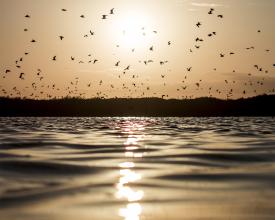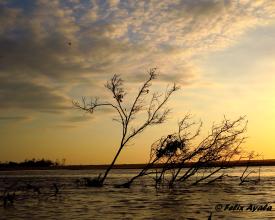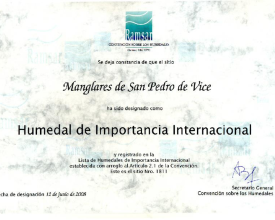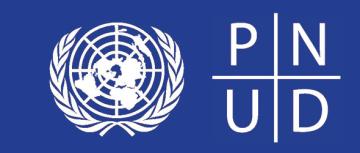
Mangroves of San Pedro de Vice: A reference in wetlands management in Peru.

The San Pedro de Vice Mangrove is a unique type of tropical forest with nationally and internationally protected species of flora and fauna and represents a refuge and feeding area for migrating birds, reproduction and growth of invertebrates and carob ecosystem.
In 2008, San Pedro Mangrove was designated the 13th RAMSAR Site in Peru. With this background, in 2013, the Pilot Project on Local Management was initiated through the formation of a Participatory Management Committee. This Committee has the purpose of ensuring the conservation of the mangrove based on the design of management tools, becoming one of the pioneers in the management of wetlands in the country.
Context
Challenges addressed
The main challenges faced by the San Pedro de Vice Mangrove are:
Environmental:
- Contamination of fresh water entering the mangrove.
- Fires at the edge of the mangrove.
- Logging in the surrounding dry forest.
- Presence of feral pigs.
- Variation in freshwater inflow.
- Poaching of birds.
Social issues:
- Excessive arrival of tourists without an exploration circuit.
- Poor access due to the poor condition of the trails.
- Unplanned and unregulated tourism.
- Little awareness of the importance of ecological preservation.
- Lack of knowledge of biodiversity values.
Economic
- Low budget.
- Unsustainable sources of financing.
Location
Process
Summary of the process
Both approaches allow for a holistic management of the area from different spheres, including environmental, social, political and economic.
It is not enough just to give a participatory approach to the project, to this must be added the real understanding of the importance of the site, internalizing this awareness through the actions carried out in order to care for and preserve the ecosystem.
Both elements or building blocks were very well coordinated to this end.
Building Blocks
Participatory approach to area management.
This has been possible thanks to a seven-year Management Plan , with the objective of "Conserving and sustainably using the biodiversity and natural resources of the Manglares de San Pedro de Vice Ramsar Site".
This Plan focuses on five components
- Value of the Ramsar Site
- Tourism
- Signage and Accessibility
- Use of natural resources and
- Governance
The participatory approach is crucial in the effective management of the area as it allows local stakeholders to be part of the decision making and implementation of actions in favor of conservation objectives.
Enabling factors
The high and effective degree of involvement of the communities in the decision-making and management processes of the area.
Lesson learned
One of the lessons learned has been the imperative need for a process of capacity building on conservation issues so that community participation is strategically aligned with the objective of the Management Plan.
A strong ecosystemic framework for the management of the area.
The adoption of an ecosystem approach to protected area management was and is crucial in this case.
The San Pedro de Vice Mangrove is a threatened habitat that supports and sustains the life of numerous endemic species of both plants and animals.
Because of this, it is vitally important not only to work at the species level but rather, considering the habitats as functional, global ecosystems, to manage them in an integral way by focusing on the management and conservation of land and water.
In other words, preserving living resources.
Enabling factors
The success in the implementation of this ecosystem focus has been due to the factual and technical understanding of the importance of mangrove management as an ecosystem, as well as the fact of having obtained RAMSAR certification , a situation that has officially demonstrated the importance of the care and preservation of the mangrove system in the area .
Lesson learned
This vision must be integrated, internalized and materialized in the daily actions of the inhabitants in order to fully understand the dynamics of the area's management and protection.
Impacts
Some of the most important impacts of this project have been:
- The development of tourism, in a more conscious and sustainable way (specialized tourism).
- The importance of the mangrove, through the recognition of RAMSAR site.
- Increased mitigation of the effects of climate change (floods and other natural disasters).
- Productive chains of handicrafts, tourism (hotels, restaurants, transportation, tour operators).
- Research through agreements with universities to promote scientific and traditional knowledge.
- Education and environmental awareness.
All these impacts have improved the conditions of use and preservation in clear benefit of the San Pedro de Vice Mangrove. This is a management plan that could be highly replicated in other similar sites.
Beneficiaries
The main beneficiaries are the inhabitants of the towns of:
- Letirá
- Becará
- Chalaco
- Sanchez
- Santa Rosa de Satuyo
- Chalaco Alto, Cercado de Vice
- Artisanal fishermen of Vice
- Local Committee of Artisanal Development of the District of Vice.
Sustainable Development Goals
Story

In 2013 we started with technical assistance from MINAM in the pilot project for RAMSAR site management models. The administration is based on the formation of participatory management committees in which local actors and institutions of the Municipality of Vice collaborate.
These actors and institutions were identified through a series of local workshops and involve key sectors such as artisans, fishermen, local associations, regional governments, NGOs.
In 2014, the first meeting of the Participatory Management Committee was held and the San Pedro Mangrove Participatory Management Plan was developed where the main activities of the RAMSAR site were defined. The Plan has been updated and activities are carried out with the full support of local stakeholders.
The management of Manglares del Vice is a reference in the country because the entire local population is committed to the management and conservation of the area. Information and cleanup campaigns are carried out constantly and the stakeholders are involved in shared management. The locals are committed to sustainable tourism, for which we are carrying out capacity building and promotional activities.
The systematization of this case was carried out by the International Union for Conservation of Nature (IUCN). The case was selected by ICLEI South America in 2018.
For more information: http://sams.iclei.org/es/que-hacemos/proyectos-en-ejecucion/areas-protegidas-locales/peru.html
The IUCN and ICLEI actions were within the scope of the regional project Protected areas and other area-based conservation measures at the local government level, and had the financial support of the Deutsche Gesellschaft für Internationale Zusammenarbeit (GIZ) GmbH. The regional project is implemented by the Ministries of Environment of Brazil, Colombia, Ecuador and Peru, and GIZ, in cooperation with ICLEI and IUCN. The regional project is supported by the German Federal Ministry for the Environment, Nature Conservation and Nuclear Safety (BMU) within the scope of the International Climate Initiative (IKI).







